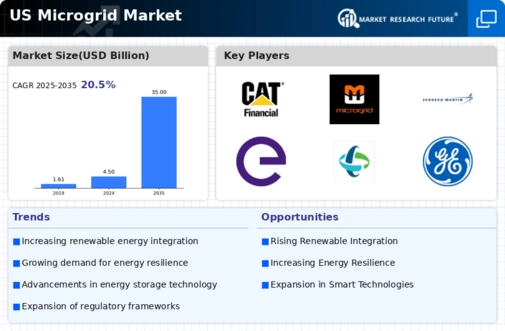The US Microgrid Market is witnessing significant growth due to increasing demand for energy independence, reliability, and environmental sustainability. The competitive landscape is characterized by a diverse array of players, each vying to assert their dominance through innovative technologies, strategic partnerships, and effective service delivery.
The market dynamics are primarily influenced by government policies, renewable energy integration, and technological advancements that enable improved efficiency and sustainability. As stakeholders strive to adapt to a rapidly evolving energy ecosystem, competition has intensified, leading to the emergence of new solutions and business models that cater to both urban and remote environments.
Companies are focusing on tailored offerings that address the specific needs of various sectors, including commercial, industrial, and residential applications, positioning themselves to capture opportunities in a market poised for expansion.Gridscape Solutions has established a noteworthy presence in the US Microgrid Market, primarily recognized for its innovative approaches and commitment to sustainability.
The company leverages cutting-edge technology to design, develop, and implement microgrid solutions that enhance the resilience and efficiency of energy systems. Gridscape Solutions is focused on delivering customized services that enable clients to optimize their energy consumption while integrating renewable energy sources. The strengths of Gridscape Solutions lie in its adeptness in management and control systems, as well as its proficiency in customer engagement and support. The company's reputation for successfully deploying scalable, efficient microgrid solutions has solidified its position in a competitive market, making it a go-to choice for customers seeking reliable energy independence and reduced operational costs.
Caterpillar has also made significant strides in the US Microgrid Market, distinguished by its extensive range of products and services tailored specifically for energy solutions. As a well-established player, Caterpillar offers a variety of power generation equipment and energy management systems designed to cater to the specific requirements of microgrids. The company's strengths include its strong brand recognition, deep expertise in power systems, and a robust distribution network that ensures widespread availability of its products.
Caterpillar actively engages in partnerships and collaborations to enhance its technological capabilities and agility in the market. Additionally, the company has pursued mergers and acquisitions to strengthen its leadership position and expand its product portfolio in the microgrid space. This strategic approach has allowed Caterpillar to not only maintain a competitive edge but also address the growing demand for efficient, resilient, and renewable energy solutions across the US.




















